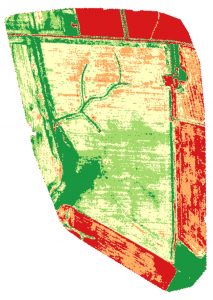Variable-Rate Nitrogen Application
Variable Rate Nitrogen Application (VR-N) works with the conditions in your field, applying more nitrogen where the crop can use it and less where additional N won’t increase yield. Struggling with yield variability in your field? Learn more about how this adaptable management strategy can increase profitability and may reduce losses to the environment.
What should I expect?
- Improved nitrogen use efficiency- By matching your fertilizer applications to your crop needs, you’ll apply nitrogen where your crop can use it. You may find that you don’t apply less nitrogen overall- increased efficiency can come from lower inputs or higher yields.
- A whole-system approach– Consider all 4 Rs– right nutrient source, rate, time & placement– in all your nutrient applications. Identify different sources of spatial and seasonal variability, and plan your N applications to be responsive to early-season conditions.
- A need for technical support- Managing data, compatibility issues and developing field-specific variable rate nitrogen (VR-N) recommendations are tasks that technical service providers or crop providers can assist with to match your goals.
Can it work for me?
Nitrogen dynamics in the soil are complex. Seasonal variability– including weather and other factors– have a significant impact on the “right rate” in any given season. Research shows that VR-N offers potential to increase nitrogen use efficiency and profitability, if 1) your fields show variability in response to N applications and 2) both spatial variability in the soil and in-season conditions are considered in the development of nitrogen recommendations.
One drawback of VR-N recommendations from historic yield or soil types is that they don’t reflect in-season conditions that affect yield potential (like temperature and rainfall), and haven’t shown a consistent advantage over flat-rate nitrogen application strategies.
The greatest potential seems to be in technologies that incorporate field characteristics, seasonal conditions and farmer input, including real-time optical sensors, remote-sensing imagery. Sensor technology is well-advanced, however interpretation of the data for a useful recommendation is an area of active research. Some new technologies have seen implementation challenges on Delmarva due to increased management complexity and compatibility issues, but the investment may be worth it. On Virginia’s Eastern Shore, VR-N in wheat saved Virginia farmers an average of 4 lbs of N per acre, which is 7% of the spring nitrogen application. In addition, side-dress N application for corn could be reduced by 21 lbs per acre while maintaining similar yields. (Thomason, et al 2011)
4Rs in the Field

In 2017, the Delaware-Maryland 4R Alliance worked with two farmers and Hoober, Inc. to evaluate the benefits of sensor-based VR-N application.
In this project, an Unmanned Aerial Vehicle (UAV, or drone) collected NDVI data prior to corn sidedress nitrogen application in the spring to identify different management zones in the field. (NDVI, or “normalized difference vegetation index” is a metric to evaluate crop vigor.) Zones with higher NDVI values were assumed to have a lower need for additional nitrogen compared to zones with lower NDVI.
NDVI appears to be a good indicator of yield potential throughout the field, and can assess conditions related to the current growing season. On one of the demonstration fields where spinach had been grown the previous year, the UAV detected areas of the field with residual soil nitrogen from the previous crop (shown in the image at left as a light green area in the field). This residual N could not have been accounted for if other methods were used to delineate areas for variable-rate nitrogen application, such as yield history or soil type.
Tools & Resources
- Extension Publication: Sensor-Based, Variable-Rate Nitrogen Applications in Virginia (Virginia Cooperative Extension)
- Extension Publication: Precision Farming Tools: Variable-Rate Application (Virginia Cooperative Extension)
- Factsheet: Variable-Rate Nitrogen Management for Corn Production– Success Proves Elusive (International Plant Nutrition Institute)
- Factsheet: Variable Rate Nitrogen Application (Delaware-Maryland 4R Alliance)
- Search for additional resources here:
Related Practices
Split Nitrogen Application, Nitrogen Modeling

